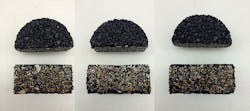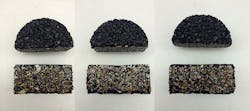By: Ramez Hajj
Preservation is critical to maintain and operate a cost-effective and safe pavement infrastructure.
Wear from traffic results in loss of skid resistance accompanied or followed by cracking, penetration of water into the pavement structure, and concomitant deterioration of the pavement. Loss of skid resistance is especially significant from a safety point of view, because a pavement with low skid resistance can increase the braking time for vehicles. In addition to remediating these serious issues, timely pavement preservation can increase the serviceable life of a pavement. Therefore, agencies often spend significant resources on maintenance.
Seal coats, also sometimes called chip seals, are one of the most common types of treatment used to restore skid resistance of an asphalt concrete pavement as well as to protect the existing pavement structure from moisture and, to some extent, oxidation. Seal coats can be constructed in many different ways, but the most frequently used type is a single-course seal coat, which consists of a layer of asphalt binder or emulsion that is overlaid by a layer of coarse aggregate.
One alternative to seal coating is to use a thin hot-mix asphalt (HMA) overlay. Many agencies have used overlays that range in thickness from 1-2 in. over the last 30-40 years. However, in order to create a more cost-effective solution, overlays with a thickness of 0.5 in. have been considered. These types of overlays are often referred to as ultra thin, although some agencies have different definitions of what constitutes an ultra thin overlay versus a thin overlay. One method to construct ultra thin overlays is the use of Novachip. Novachip is applied using a specialized machine that can apply tack coat and HMA simultaneously in one pass. It generally uses a heavy load of tack coat in order to ensure proper bonding and prevent surface penetration of water.
The study described in this article was an experimental study conducted between the University of Texas-Austin and the University of Texas-El Paso. The study had two main goals: Explore the different possible aggregate gradations that could be used in a mix applied as an ultra thin overlay, and identify and validate a volumetric criterion for laboratory mix design that can determine the optimum binder content at which mixes will perform best when applied as ultra thin overlays.
Three mixes were determined to have ultra thin overlay viability: a 9.5-mm gap graded; 9.5-mm coarse graded; and a 4.75-mm gap graded/open graded mix.
Finding the right candidate
The first step in this study was to consider possible aggregate structures that could be used. In order to generate possible aggregate structures, a review of the specifications from all 50 states was conducted to determine the types of mixes used in different states that could potentially be used to build thin overlays. From this review, six candidate gradations were chosen. The maximum aggregate size was a controlling factor, since the maximum aggregate size could not be greater than the thickness of the overlay
(0.5 in.). The six candidate gradations that were selected were as follows:
- 9.5-mm gap graded;
- 4.75-mm gap graded;
- 4.75-mm fine dense graded;
- 9.5-mm fine dense graded;
- 9.5-mm coarse dense graded; and
- 4.75-mm gap graded/open graded.
Once the candidate gradations were selected, the binder was then chosen. A PG 70-22 binder was selected. Although an upper grade of PG 76 is very common for ultra thin overlays, a PG 70 was selected in this case for evaluation in order to reduce the overall cost of the mix. In addition, PG 70 can be beneficial from a compaction point of view, since ultra thin overlays are prone to rapid cooling when applied in the field. This rapid cooling combined with a very stiff binder such as PG 76 can result in a significant workability problem. In order to then select binder contents for use in this study, researchers conducted a traditional volumetric mix design with the criterion for optimum binder content being 4% air voids at 50 gyrations in the Superpave Gyratory Compactor. For five out of six mixes, the optimum selected was between 6% and 7% asphalt binder. The last mix (4.75-mm fine dense graded) was substantially higher at 8.8% binder. In addition to meeting this design criterion, other criteria also were checked, such as Voids in Mineral Aggregate (VMA) and Voids Filled with Asphalt (VFA).
However, part of this study was to determine if this volumetric criterion does in fact yield mixes with the best performance as an ultra thin overlay. Therefore, in addition to performance testing in the lab on the mixes at the volumetric optimum, mixes also were developed at binder contents 0.5% higher and 0.5% lower than the volumetric optimum determined during mixture design.
Three performance-based test methods were selected to evaluate the mixes described above: the Hamburg Wheel Tracking Device (HWTD) test, the Texas Overlay Test and the Three Wheel Polishing Device (TWPD) Test developed by the National Center for Asphalt Technology (NCAT). The first test, the HWTD test, is a common test for determining moisture and rutting resistance of asphalt mixtures. In this study, two forms of this test were performed on the set of mixes. One was the traditional test that involves a 2.3-in.-thick specimen submerged in water at 50°C, and then passed over repeatedly with a steel wheel applying a load of 158 lb. The deformation of the specimen was measured, with a failure criteria set at less than 0.5 in. of rutting at 15,000 cycles. This test was run as a baseline on all six of the mix types at their volumetric optimum binder content to determine which types showed superior moisture resistance. Three of the mix types passed the criteria, while the other three failed by a substantial margin. Those that passed were the mixes with majority coarse aggregates, while those that failed were those with more fine aggregates.
The second form of the test performed involved a modified specimen, which consisted of a polymer base with similar modulus to asphalt binders overlaid by a 0.5-in.-thick asphalt layer. These were bonded together using a polymer-modified tack coat, and the specimen was compacted in the Superpave Gyratory Compactor. Then the same test procedure was run on these specimens. With regard to the modification of this test, there was no established failure criterion, but it was observed that these thin specimens failed sooner than the traditional specimens, but that the coarse mixes still showed a superior performance. It also was observed that for most mixes, the mix compacted at the volumetric optimum binder content performed better than the ones at higher or lower binder contents.
The Texas Overlay Test is another common test used to determine the fatigue cracking resistance of an asphalt mixture. Although it is thought that fatigue cracking will not be much of an issue with these types of mixes due to their high asphalt binder content, this test was done for completeness. Specimens were subjected to high strain triangular loading with a period of 10 seconds for 1,000 cycles at 25°C. Since the HWTD test showed that coarse mixes were more viable, this test was only performed on those mixes. It was observed that the three coarse mix types all showed a higher first cycle peak load (meaning a higher resistance to forming an initial crack) at the volumetric optimum binder content. However, mixes with a higher binder content showed less reduction in load throughout the test. Nonetheless, as expected, all of the mixes at high or volumetric optimum content showed excellent resistance to cracking in this test, as none of these formed a visible crack.
Finally, the TWPD test was used to evaluate skid resistance of the different mixes. The TWPD was developed by NCAT to simulate traffic wear on the surface of a pavement. The device consists of three pneumatic tires that rotate in a 284-mm-diam. circular path on the surface of an asphalt slab, while the slab is sprayed with water primarily to remove any debris from wear caused by the tires. The circular path matches the path of standard measurement tools such as the Dynamic Friction Tester (DFT). A tire pressure of 50 psi and an overhead load of 91 lb were used in this study. The slabs were molded in a ½-in.-thick aluminum mold with an aluminum base, which is the same as the target layer thickness of the ultra thin mix. A target air void content of 7% was used, and a sample of the mix was compacted using a manual rolling compactor. In order to adhere the specimen to the metal base, a cold-applied CQS-1HT trackless tack coat was used. The friction resistance of the surface was measured by removing the specimen from the TWPD and using a DFT after a predetermined number of cycles.
This test was performed on all six of the mix types at their volumetric optimum binder content. It was observed that the mixes with a higher nominal maximum aggregate size (9.5 mm compared to 4.75 mm) showed better performance throughout the test up to 100,000 cycles, which was expected due to a better macrotexture. The coarse mixes also were then evaluated at all three binder contents in this test, at which the volumetric optimum generally showed better performance in terms of skid resistance, pavement deformation, and a visual inspection of bleeding and raveling.
Lab results
Based on the above results, the following conclusions were drawn regarding laboratory design of ultra thin overlay mixes:
- Three mixes that can potentially be used as an ultra thin surface layer are a 9.5-mm gap graded mix, a 9.5-mm coarse dense graded mix, and a 4.75-mm gap graded/open graded mix;
- DFT values for laboratory-produced ultra thin overlays were comparable, and in some cases a bit higher than those for seal coats based on other studies;
- Mixes at their volumetric optimum binder content with a criteria of 4% air voids at 50 gyrations in the Superpave Gyratory Compactor generally perform better than mixes at slightly higher or lower binder contents, indicating that the volumetric optimum is a good criterion for mix design of ultra thin mixes;
- Mixes with majority coarse aggregates and higher nominal maximum aggregate sizes generally performed better than finer mixes; and
- The TWPD in combination with DFT shows adequate sensitivity to mixture type and binder performance to be used as a performance tool for ultra thin mixes.
Future work is, however, needed to determine other variables such as the influence of using different types of tack coats and the incorporation of recycled material (RAP or RAS) in the design of ultra thin overlay mixes.
Acknowledgement—The author acknowledges the Texas Department of Transportation for funding several parts of this study.
About The Author: Hajj is a research assistant at the University of Texas at Austin.




